We’re here to help! Wild Yards is a completely free website that is 100% dedicated to helping you create a wildlife-friendly, sustainable yard. Read more
WildYards is reader-supported. When you buy a product through a link on our site, we may earn a comission. Every product is independently selected by our (obsessive) editors and our reviews are unbiased and objective. Read more about our mission or our privacy policy.
Hummingbirds are famously voracious little beasts. Despite their small size, they consume vast quantities of calories and sugar to keep their metabolisms running – they are almost always facing starvation! With that in mind, what do hummingbirds eat, anyway?
Hummingbirds enjoy a rich diet of nectar, insects, fruit, and sap. They often feast on nectar and natural sugar, most of all thanks to the energy boost – but they’ll need vital nutrients and minerals from other sources, too.
9 Things Hummingbirds Eat
It’s a common misconception that hummingbirds purely feed on nectar or the bugs and insects that you’ll find nibbling away at flowers. While it’s a great idea to attract hummingbirds to your garden with brightly colored, fragrant blooms, it takes more than a few plants to feed these ever-fluttering creatures. Let’s break down what makes up the majority of their diets.
Nectar
Nectar is the number one food source for hummingbirds as it’s both dense in natural sugar (great for energy), and it’s abundantly available in the wild. Regular top-ups of sucrose will help to keep hummingbirds beating their wings and avoiding having to crash into torpor. Hummingbirds stop to rest occasionally – but much of the day, they will be actively foraging for food from various flowers and plants.
Nectar doubles as both caloric sustenance and liquid hydration for hummingbirds, which is why it may be rare you see them drinking water alone. Hummingbird nectar is, effectively, the fuel they need to fill up on almost constantly. Interestingly, though, they can’t subsist on nectar alone to survive.
Hummingbirds won’t flock to just any flower to eat nectar from. They prefer dipping into plants shaped perfectly for their beaks, particularly those with trumpet-shaped blooms. To attract hummingbirds – and keep them well-fed on that all-important nectar – it’s worth growing flowers that attract hummingbirds such as lantanas, snapdragons, fuchsias, sunflowers, morning glories, wisteria, gardenias, azaleas, and calibrachoa – the list does go on!
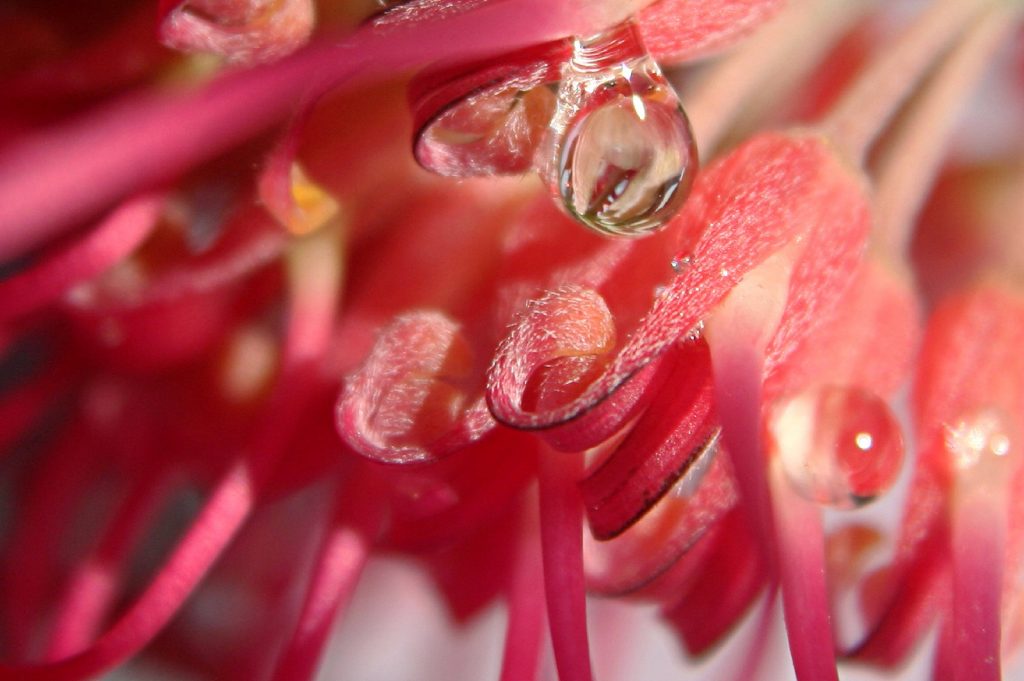
Bugs and insects
While nectar is abundant in sugar and calories, it has zero protein. Hummingbirds are just as opportunistic as they are voracious, which means they will happily snap flies, mosquitoes, and aphids out of the air – thus providing protein and other nutrients to help fill the gaps in their diet left behind by nectar alone. They’ll also feast on bugs that crawl around plants, too.
Hummingbirds tend to eat flying insects mainly because they will breed around flowers and sweet sources of food elsewhere in the wild – and in gardens, too. Mosquitoes are famously ubiquitous, which means it’s rare a hummingbird in the US will go without this flying snack during the warmer months.
Hummingbird beaks rarely open, if at all – meaning one of the rare times you’ll see them open their mouths is when an unwitting minibeast flutters in the wrong direction.
That said, there is some evidence that hummingbirds will pluck and fish insects out of flowers and webs left behind by spiders if they’re particularly low on protein. As omnivorous creatures, hummingbirds don’t show much of a discerning taste for what pops up in the garden (and your local habitat) – unless they are physically unable to manipulate their beaks.
Many tiny, winged insects are ubiquitous and small enough to warrant a lightning-quick snack for most hummingbirds fluttering across the US, meaning they can make fantastic mosquito controllers – all the more reason to plant hummingbird-friendly flowers to keep them coming back.
The way hummingbirds hunt for and feed on insects can vary from species to species. For example, the rufous hummingbird may scour leaves for bugs after drinking flower nectar. The calliope hummingbird, meanwhile, is a relatively daring breed – choosing to perch occasionally to feed on any insects that dare to flutter close by.
Some species – such as the ruby-throated hummingbird – will even munch on caterpillars it finds on the plants they visit the most.
Ants
Ants, much like flying insects, often get snapped up by hummingbirds when they’re in the wrong place at the wrong time. Hummingbirds will eat ants if they intrude upon their nectar feasts, or if they are scattered around sweet fruit and sap they’re feeding on elsewhere.
Interestingly, ants are one of the very few creatures likely to get eaten by hummingbirds while actively competing for food. Much like their bird rivals, ants will typically chow down on sugary, sticky food, and work in droves to harvest it for their families. Ant populations across the globe are truly enormous – which means that despite hummingbirds being likely to pick them off if they intrude on a meal, losing a few team members won’t harm their place in the ecosystem.
If you’re setting up a hummingbird feeder in your garden, it’s worth protecting what you leave for your birds with an ant moat or similar. Ants rarely cross water by choice, so you can ensure your hummers get exclusive access to their feeders. While ants will certainly never win a fight with a hummingbird, they can deplete their food sources highly efficiently!
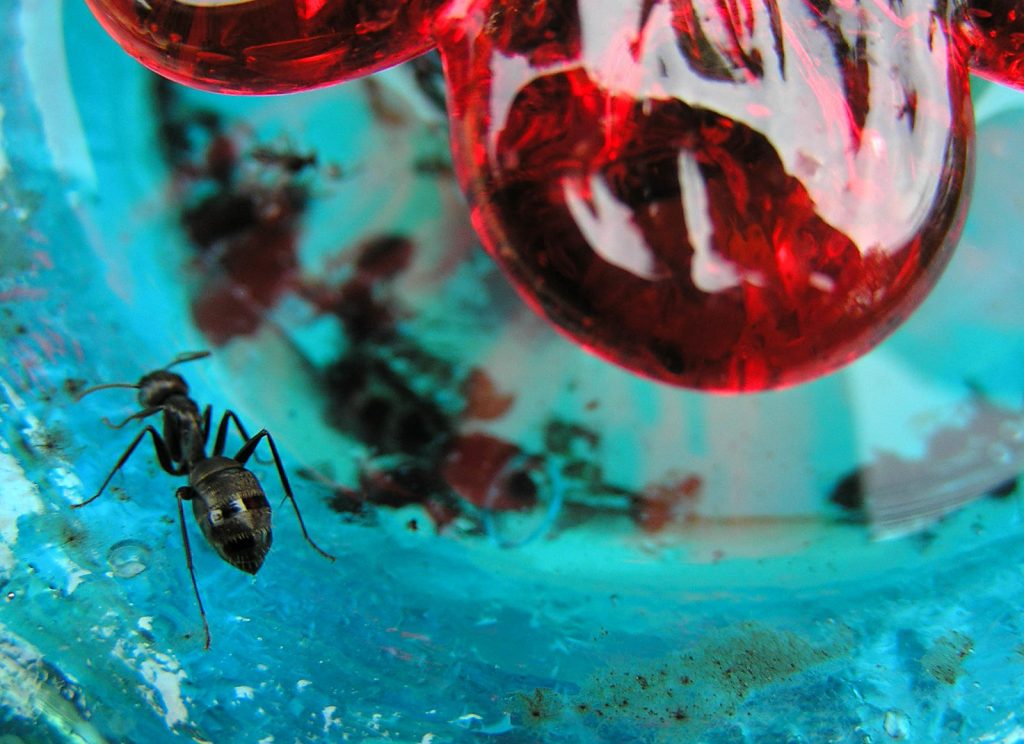
Spiders
Strange but true – hummingbirds won’t purely eat flies, but spiders, too. While spiders tend to be higher up the food chain than many other smaller beasts in the garden, hummingbirds will snack on unsuspecting spiders if they get in the way. What’s more, as they are small and are unlikely to move too quickly for the speedy hummingbird, they are some of the easiest prey to catch.
Spiders, much like ants, can occasionally compete with hummingbirds for some food. While spiders will generally munch on smaller insects and flies, they can also eat nectar – meaning hummers risk losing serious sugar and abundant protein. Hummingbirds can take care of this problem fairly efficiently – they have even been found to stalk webs occasionally to snap up a spider or two.
Scarily enough, some spiders out there will give as good as they get – and will dare to try and eat hummingbirds in return. Spiders who emit venom – such as orb-weaving species – can paralyze and even kill hummingbirds if they intrude on their nests. As opportunistic and as brave as hummers may seem, not all are prepared for their food to fight back – especially considering the spiders they eat typically won’t produce enough venom to harm them.
Pollen
It’s perhaps reasonable to expect a hummingbird to eat pollen alongside nectar if it inspects flowers deeply enough. Intriguingly, while this can happen, it’s not thought to be a purposeful act!
Hummingbirds are famously messy eaters – using their tongues like straws, or pumps, to slurp liquid nectar from flowers that appeal to them. With this, there will likely be some pollen clusters that get stuck in the nectar hummers drink up. It’s easy to assume that pollen provides reliable protein for hummingbirds – and while it does contain some of this essential nutrient, these pollinators don’t feed on it directly.
Pollen is extremely tricky for hummingbirds to digest – less than 10% of pollen eaten may fully degrade in their stomachs. Hummers won’t seek out pollen for protein, instead choosing to feast on small insects. Regardless, they will still spread pollen across your garden while hunting for other food.
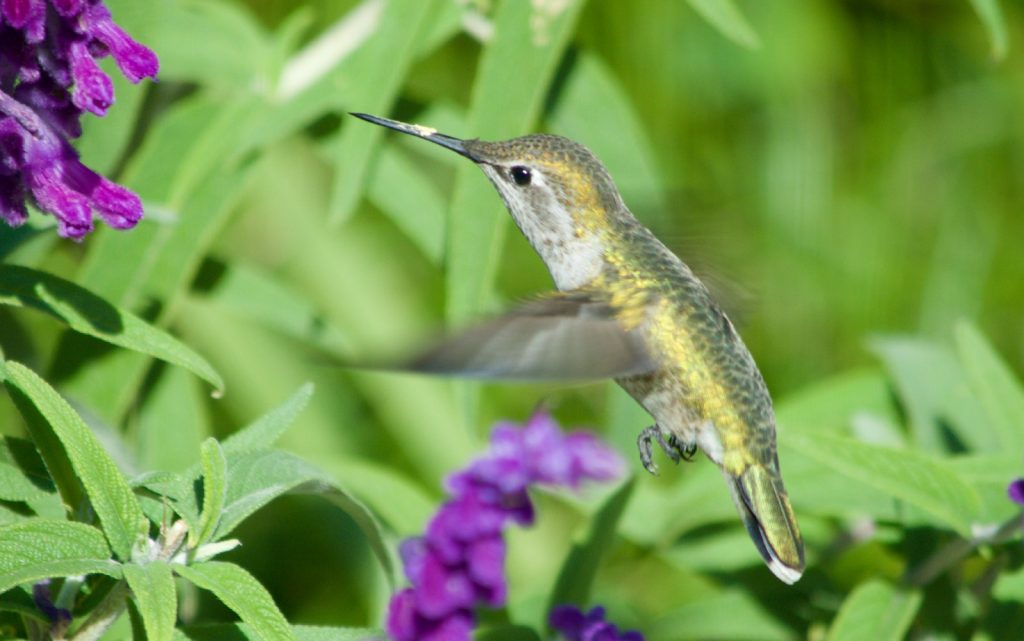
Fruit
Naturally sweet thanks to abundant sugars, hummingbirds will find most fruit attractive – bananas and oranges, for example, are high up on their wish lists. Fruit that’s growing ripe will likely appeal to hummers more than most.
Hummingbirds will drink fruit juice if it’s available, probing their beaks into the softest of fruits so that they can easily pump sugar through their impressive tongues. Oddly enough, various studies seem to disagree on exactly why hummers choose to eat fruit – but the educated guess is that it’s all about the sugar.
Many gardeners, for example, will leave bits of fruit out for hummingbirds to enjoy as part of a feeder. It’s a welcome snack if there are very few flowers around providing enough nectar, for example.
Therefore, fruit such as bananas, oranges, and watermelons are extremely beneficial to hummingbirds thanks to their rich vitamin and fiber content, giving them extra nutrients to balance out sugar calories and insect protein.
Grape jelly
While hummingbirds feed on a wide variety of natural food sources, they are also partial to enjoying a handful of artificial treats – though you will need to be careful with artificial colors and additives. Grape jelly proves highly popular with hummingbirds thanks to the pure sugar content. Derived from real fruit, this type of jelly or preserve proves to be a smash hit with hummers looking for a quick sugary hit wherever possible. Alongside serving oranges and other juicy fruit in a hummingbird feeder, serving up grape jelly is a great way to get hummingbirds to visit you regularly.
Do make sure to serve sparingly, however, as hummingbirds will still need to rely on natural sources of sugar to thrive in your garden. They’re unlikely to grow dependent on your grape jelly treats, but make sure to provide a balance.
Tree sap
Hummingbirds don’t commonly drink sap from trees, but on occasions where they are unable to find nectar from flowers in their habitat, they will drink from wells in the bark. These holes are typically pre-drilled by woodpeckers, who may also drink sap if food is scarce (in particular, it’s the appropriately-named sapsucker species who partake in this liquid the most).
Sap isn’t ideal food for hummingbirds, but it will still provide some natural sugar they can use for energy. A hummingbird feeding from a tree is likely struggling to find flowers they can rely on – all the more reason to grow some in your yard.
Sand
Perhaps bizarrely, some hummingbirds are found to eat sand, dust, and ash – and it’s likely a result of a vitamin or sodium deficiency. It’s extremely rare you will see hummingbirds feeding on powder of any kind, though they may also be picking away at insects and bugs they can find in between.
Crucially, there’s not yet enough evidence or research to firmly explain this odd side of hummingbird behavior. For sure, you won’t be able to attract hummingbirds with a sandpit alone in your yard!
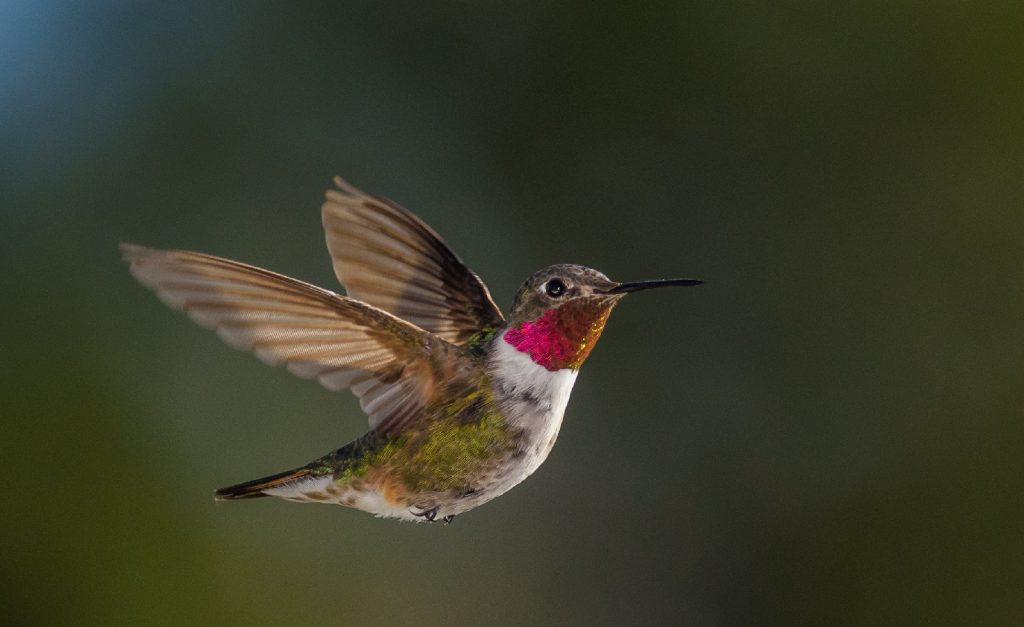
What do hummingbirds avoid eating?
Hummingbirds, while desperately hungry, omnivorous, and hardly selective, can typically only eat and drink what their specialized anatomy can allow. For example, hummingbirds will avoid eating anything that requires crunching or is too big for their beaks. Otherwise, there are some species of insect that they’re not observed feeding on, either.
Here is a list of wild food some assume hummingbirds will eat – but typically don’t.
Seeds
The hummingbird is one of few birds that won’t eat seeds by choice. The main reason is that their beaks simply aren’t fit to peck or crunch through these common wild treats. Anything with a hard shell, or which requires pecking to pick up and eat, will go overlooked – as a result of these birds’ curious evolution.
The hummingbird’s distaste for seeds also stems from its curious metabolism, or rather, its physical refusal to digest this type of food. Seeds don’t provide hummingbirds with enough quick-release energy to keep them active – and these birds simply aren’t powerful enough to digest anything more than a largely liquid and insect-based diet.
This rule applies to grains and nuts, too. If you fill a hummingbird feeder with any of the three, it simply won’t get eaten – by the birds, in any case.
If you ever spot a hummingbird appearing to peck at seed, it’s more likely they are looking for bugs. Some anecdotal reports suggest hummers are known to try and peck around – but this is never the case – they simply lack the apparatus!
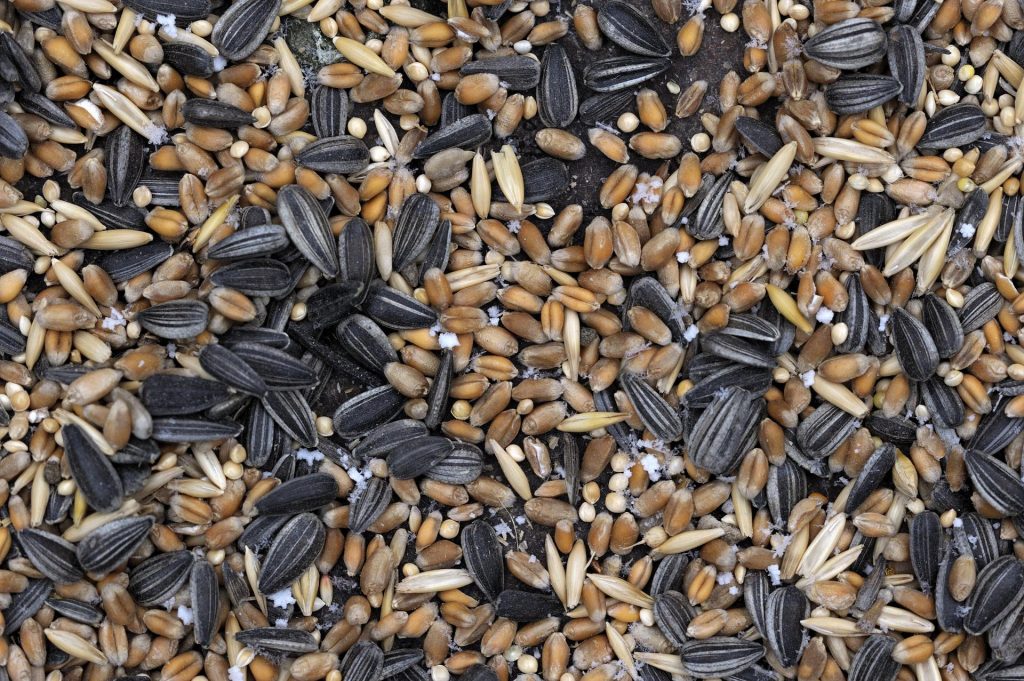
Worms
Worms are also popular bird staples that hummingbirds happily avoid – the main reason is that they are, again, not equipped to eat these creatures. Their beaks can’t open wide enough to swallow worms, and they don’t have the teeth to chomp and chew through them. It’s extremely rare, but hummingbirds may eat mealworms occasionally if in a feeder – but it’s best to keep it topped up with sugary items.
A further reason why hummingbirds won’t eat worms is simply that they don’t tend to come across them while flying around. Worms will, by their nature, burrow through soil – while hummingbirds rarely, if ever, head towards solid ground. It’s safe to assume that worm and hummingbird species have largely evolved without crossing paths.
Hummingbirds also don’t have the time spare to spend hunting and digesting worms – they need quick fixes of sugar they can drink on the go – hovering around nectar-filled plants, for example.
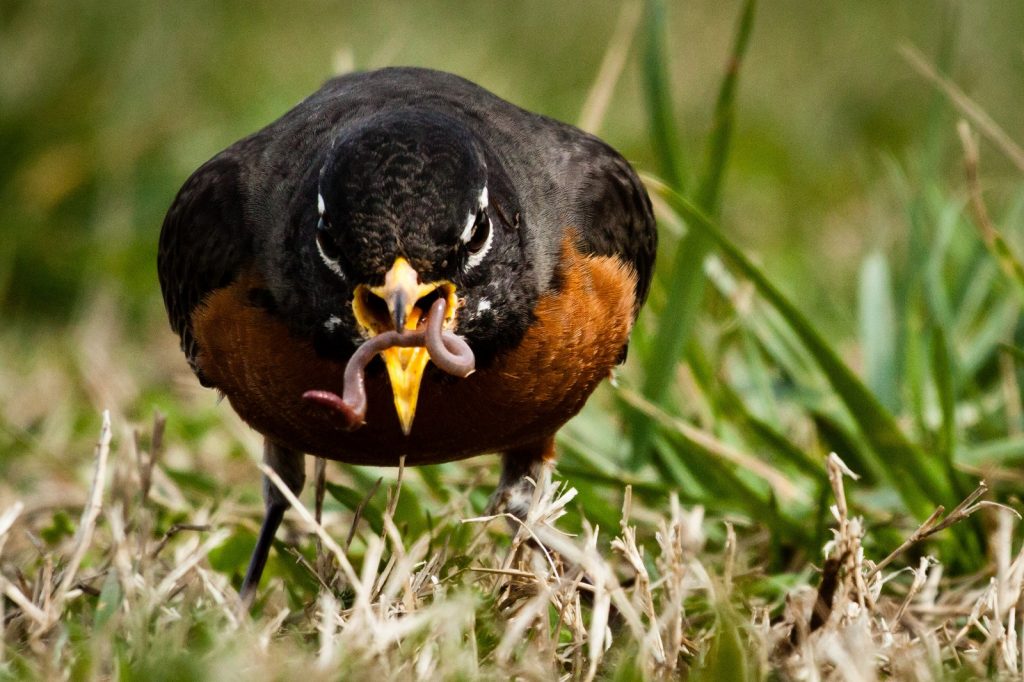
Tomatoes
While many anecdotal reports suggest that hummingbirds enjoy eating tomatoes, they won’t typically choose to feed on such plants. Hummingbirds may enjoy taking a quick drink from a juicy tomato if they desperately need hydration, or if they are looking for a sweet fix. Otherwise, it may be that they have spotted bugs or insects around tomato plants, and simply look as if they are feeding on the fruit.
It’s a smart move to grow tomato plants in your yard if you still want to support your local hummingbirds. While they may not attract these pollinators directly, they will attract insects in droves – providing you don’t use insecticides or chemicals to deter minibeasts, hummingbirds will have a variety of protein-filled snacks to feast on.
Butterflies
While hummingbirds famously eat bugs and insects to fill up on protein, they won’t typically eat butterflies. At least, there’s no particular evidence to suggest this is the case. Hypothetically, a hummingbird trying to eat a butterfly may physically struggle to swallow the creature – they are much larger, on average, than the bugs hummingbirds snap up opportunistically.
This explains why you will commonly see hummingbirds and butterflies fluttering around the same plants, neither intruding on the other. They may compete for nectar, but hummingbirds simply don’t have the time to attack, eat and swallow butterflies.
Conversely, hummingbirds may eat butterflies at an earlier stage of life. Certain species of hummingbird (such as the ruby-throat, as mentioned above), are unafraid to pick caterpillars off leaves if they’re in need of a quick protein hit.
Bees and wasps
There’s insufficient evidence to suggest that hummingbirds will eat bees and wasps in particular among winged creatures, and this may be for a fairly obvious reason. Both bees and wasps are unafraid to sting and secret venom when they feel threatened, and it may be that hummingbirds have simply evolved to avoid risking their chances. There’s very little concrete information to explain why they generally avoid snapping up black-and-yellow buzzers, otherwise.
This, again, proves interesting from the perspective of pollination competition. Bees and butterflies are the hummingbird’s biggest rivals when it comes to feeding on colorful flowers – and this is likely the case because the bird simply can’t eat its competition without hurting itself.
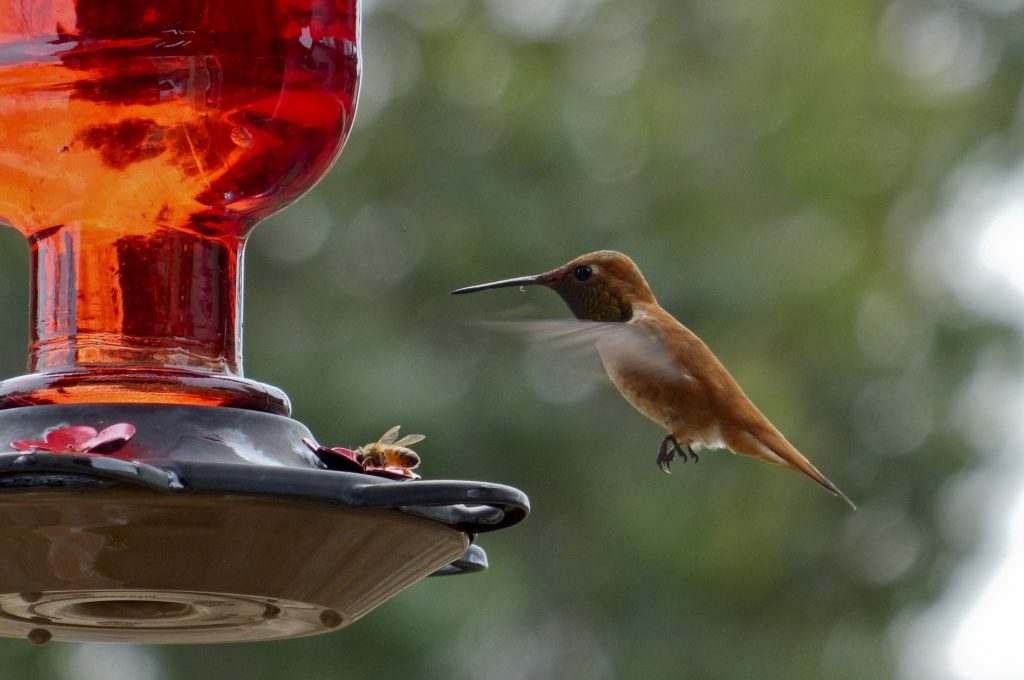
Do hummingbirds ever drink?
While many hummingbirds will get the hydration they need from the nectar they eat from flowers, they are still likely to need fresh water from time to time. Hummingbirds will take quick gulps of water from tiny droplets you may find hanging from leaves early in the morning. They will also choose to drink after the rain has passed.
Despite this, it’s common for gardeners to leave water out for hummingbirds. They will sometimes attend bird baths, but you must keep them clean – and relatively shallow. Hummers will drink from puddles and small pools of water on occasion. Given their territorial nature, it’s unlikely that hummingbirds will willingly share a bath with other birds – though, as anecdotal reports suggest, stranger things have happened.
Why are hummingbird diets so strange?
Compared to other avian species, the average hummingbird burns off energy – and flaps its wings – at a blistering rate. Thus, its diet is more ‘fast food’, and less ‘keep in storage for later’. The hummingbird’s heart has the potential to beat more than 1,000 times per minute – and it spends the vast majority of its day flapping its wings, around 70 times each second. That’s going to require a lot of energy.
This means hummingbirds have evolved to feed on liquid food that’s rich in sugar, likely to give them fast calorie boosts to keep them from starving to death. And unlike many birds, the hummer needs to feed almost constantly.
This is why its beak and tongue have evolved to quickly dip in and out of available flowers. While the hummingbird will open its beak occasionally to snap at insects, time is very much of the essence. That means hummers will only spend a few seconds at each flower, hovering while drinking deeply from nectar sources.
When it finally comes time to rest, the hummingbird enters torpor, an almost hibernation-like state – reducing its heart rate massively to survive a good night’s sleep.
How can I help to feed hummingbirds in my local area?
The number one way to help ensure hummingbirds near you get enough to eat is, of course, to grow plenty of nectar-rich flowers. Choose blooms that are bold in color, trumpet or tube-shaped where possible, and which grow out in the open. It’s unlikely you will deter hummingbirds with specific flowers, but the flatter, more open-faced blooms are more likely to welcome butterflies.
You can also set up feeders for hummingbirds, filled with sweet treats such as sugar water and fresh fruit. Even rotting fruit may prove tasty to most hummers – it all means extra sugar!
It’s generally good to feed hummingbirds away from other creatures in your garden. While other creatures may not steal from your birds’ food supplies (unless you have a spate of ants or spiders looking for sugar), you need to consider the average hummer’s behavior around other species!
Hummingbirds, as a result of their desperation to feed, can show aggressive and even bullying behavior, keen to get to their food as quickly as possible – and not really caring who gets in their way!
Specialist hummingbird feeders, which you’ll find at online retailers and some pet and garden stores, help keep ants and insects away from nectar water and other food. These feeders are also designed purely for hummingbirds to access – with small inlets where they can probe beaks and drink from food left within. This is not only convenient for hummingbirds, but also helps to keep any food that is competed for well out of the way of others.
In rare cases, you may find that hummingbirds avoid feeders altogether. It may simply be the nesting season, in which case your local birds may have built their laying spots close to where they know they have wild food supplies to hand. Otherwise, it may simply be that hummingbirds in your area are migrating.
Otherwise, a lack of hummingbirds fluttering around a feeder may simply mean they’ve found a tastier source of nectar and protein elsewhere. If your garden’s full of colorful, nectar-laden flowers, there’s often little need for a separate hummingbird feeder.
Should I worry about hummingbirds starving?
No – while the hummingbird’s near-starvation scenario may seem a little scary, their biology exists thanks to thousands of years of evolution. Hummingbirds don’t necessarily need our help to find food and water from day to day, but we owe it to them to keep our yards and gardens full of beautiful flowers they can feed from.
Hummingbird diets are some of the weirdest and most wonderful in the animal kingdom. While they won’t eat much of what other garden birds like to feast on, they have no difficulty finding tasty treats to keep their wings fluttering.